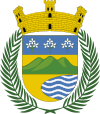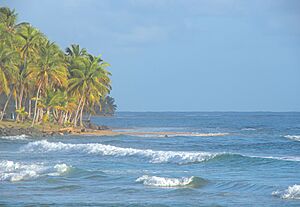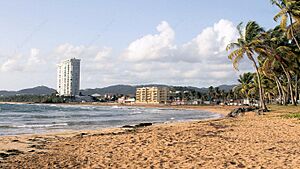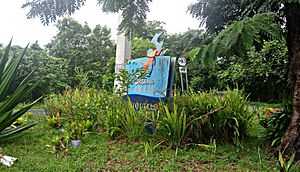Luquillo, Puerto Rico facts for kids
Quick facts for kids
Luquillo
Municipio de Luquillo
|
|||
|---|---|---|---|
|
Town and Municipality
|
|||
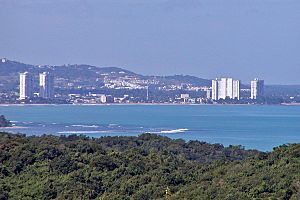
High rise buildings in Luquillo.
|
|||
|
|||
| Nicknames:
"Capital del Sol", "La Riviera de Puerto Rico", "Los Come Cocos"
|
|||
| Anthem: "Junto a las costas del mar Atlántico" | |||

Map of Puerto Rico highlighting Luquillo Municipality
|
|||
| Sovereign state | |||
| Commonwealth | |||
| Settled | 1719 | ||
| Founded | October 26, 1797 | ||
| Barrios | |||
| Area | |||
| • Total | 34.26 sq mi (88.73 km2) | ||
| • Land | 26 sq mi (68 km2) | ||
| • Water | 8.00 sq mi (20.73 km2) | ||
| Population
(2020)
|
|||
| • Total | 17,781 | ||
| • Rank | 64th in Puerto Rico | ||
| • Density | 519.02/sq mi (200.394/km2) | ||
| Demonym(s) | Luquillenses or Luquillanos | ||
| Time zone | UTC−4 (AST) | ||
| ZIP Code |
00773
|
||
| Area code(s) | 787/939 | ||
| Major routes | |||
Luquillo is a beautiful town and municipality in Puerto Rico. It's located on the northeast coast, near Fajardo and Rio Grande. Luquillo is famous for its stunning beaches and its closeness to the El Yunque National Forest, a lush rainforest.
The town is about 26 square miles and has 12 miles of Atlantic coastline. This mix of ocean and rainforest creates a very special environment. Luquillo is also the start of the Northeast Ecological Corridor Nature Reserve. This means you might see rare or endangered species, like the leatherback turtle, when you visit!
Contents
History of Luquillo
Luquillo was founded in 1797. It has some cool nicknames like "La Capital del Sol" (Capital of the Sun) and "La Riviera de Puerto Rico" (the Puerto Rican Riviera). People also call its residents "Los Come Cocos" (the coconut eaters).
One story says the town was named after an Indian chief called Loquillo. He lived around the early 1500s. However, it's more likely that the name Luquillo comes from Yukiyu. This was the Taino name for El Yunque mountain. It probably means "white mountain," referring to its foggy peaks.
In 1989, Hurricane Hugo caused some damage to the town. Years later, on September 20, 2017, Hurricane Maria hit Puerto Rico very hard. In Luquillo, rivers overflowed, and there were landslides. The power went out, and many homes were damaged or destroyed.
Geography and Natural Beauty
Luquillo is located on the northeast coast of Puerto Rico. Its unique location between the Atlantic Ocean and El Yunque rainforest makes it a place with amazing natural beauty.
Luquillo's Barrios
Like all municipalities in Puerto Rico, Luquillo is divided into smaller areas called barrios. The main downtown area, where you'll find the municipal buildings and a large Catholic church, is called "el pueblo".
Here are the barrios that make up Luquillo:
Fun Things to Do in Luquillo
Luquillo is famous for its beautiful beaches. There are 14 beaches here! One of them is La Pared, which means "The Wall." It's known for its strong waves.
If you travel east from San Juan, you'll find Luquillo Beach. This beach is officially called La Monserrate Beach (Balneario de la Monserrate). It's a huge beach with many coconut palm trees that provide shade. The sand is fine and shimmering. It's one of the most popular public beaches in the area. It has cafeterias, restrooms with showers, and parking. It's also accessible for people with disabilities.
Another cool spot is La Selva. It's a small cove on the east coast and a great place for surfing. To get there, you usually have to walk about two miles through a cow farm.
Landmarks and Places to Explore
When you visit Luquillo, here are some interesting places to see:
- Chief Loquillo Monument
- La Fortuna Hacienda
- La Bandera Beach
- La Monserrate Beach (also known as Luquillo Beach)
- La Pared Beach
- Las Pailas Beach
- Mameyes Beach
- Ocean View Boulevard
- Fortuna Beach
- The Recreational Park
- The Kiosks at Luquillo Beach (famous for local food and crafts)
- La Selva Reef Break
Culture and Celebrations
Luquillo loves to celebrate!
Festivals and Events
The town celebrates its patron saint festival in March. This event, called Fiestas Patronales de San Jose, is a religious and cultural celebration. It usually includes parades, games, local artisans, fun rides, delicious regional food, and live music.
Other exciting festivals and events in Luquillo include:
- Leatherback Turtle Festival - April
- Festival de Zangueros - June
- Coconut Festival - September
- Traditional Cooking Festival - December
Luquillo's Population
| Historical population | |||
|---|---|---|---|
| Census | Pop. | %± | |
| 1920 | 6,251 | — | |
| 1930 | 7,799 | 24.8% | |
| 1940 | 8,851 | 13.5% | |
| 1950 | 9,967 | 12.6% | |
| 1960 | 8,582 | −13.9% | |
| 1970 | 10,390 | 21.1% | |
| 1980 | 14,895 | 43.4% | |
| 1990 | 18,100 | 21.5% | |
| 2000 | 19,817 | 9.5% | |
| 2010 | 20,068 | 1.3% | |
| 2020 | 17,781 | −11.4% | |
| U.S. Decennial Census 1920-1930 1930-1950 1960-2000 2010 2020 |
|||
Luquillo is home to many people. In 2020, about 17,781 people lived there. The people of Luquillo are called Luquillenses or Luquillanos.
Here's a look at the different groups of people living in Luquillo in 2005:
| Ethnicity - Luquillo, Puerto Rico - 2005 | ||
|---|---|---|
| Race | Population | % of Total |
| White | 10,112 | 57.4% |
| Black/African American | 4,345 | 23.7% |
| American Indian and Alaska Native | 120 | 0.6% |
| Asian | 62 | 0.3% |
| Native Hawaiian/Pacific Islander | 3 | 0.0% |
| Some other race | 2,933 | 14.8% |
| Two or more races | 610 | 3.1% |
Getting Around Luquillo
There isn't a public bus system in Luquillo. People usually get around using services like Uber or local taxis.
The main road that goes through Luquillo is PR-3. There are also other important local roads like PR-983, PR-988, PR-991, and PR-940. Luquillo also has 20 bridges.
Symbols of Luquillo
The municipality of Luquillo has its own official flag and coat of arms. These symbols represent the town's history, nature, and culture.
Luquillo's Flag
The flag of Luquillo has three horizontal stripes. The top blue stripe and the bottom green stripe are each twice as wide as the yellow stripe in the middle. The blue color stands for the sky and the sea. The yellow represents the sandy beaches. The green symbolizes the lush vegetation of the mountains. In the center of the yellow stripe, you'll see the town's coat of arms. It's surrounded by two palm tree leaves crossed at the bottom.
Luquillo's Coat of Arms
The coat of arms has a gold background. In the center, there's a mountain range with three green mountains. Below them, there's a bay with blue and silver waves. The top part of the shield is blue and has three iris branches. Above the shield, there's a gold crown with three towers. On the sides of the shield, two palm tree leaves are crossed at the bottom.
Images for kids
See also
 In Spanish: Luquillo para niños
In Spanish: Luquillo para niños



